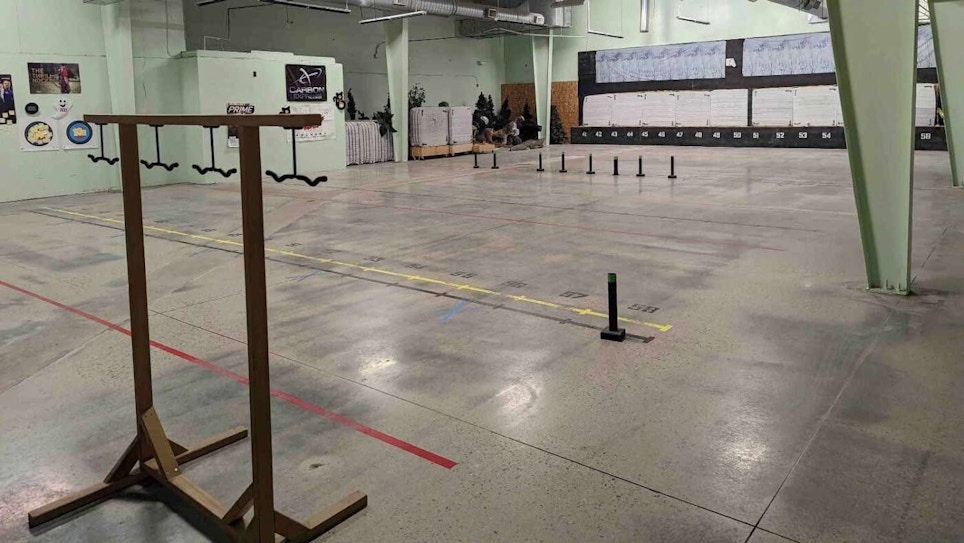
A 24-hour range gives archers a way to practice on their own schedule. The one shown here is operated by High Altitude Archery in Longmont, Colorado.
As an archery retail shop owner, have you noticed how many of your customers try to squeeze in practice after work? Or how many swing by for a quick practice session on their break? Having a 24-hour archery range would give your customers a way to access a range at any hour that’s convenient for them. We spoke with Paul Williams, coach and manager at High Altitude Archery in Longmont, Colorado, to gather his insight on the pros and cons of offering a 24-hour archery range.
Williams shared that they were inspired to try a 24-hour range after hearing about other ranges around the country trying the same thing, as well as seeing the success of it through gyms, rowing clubs, and other recreational businesses. “I'm also aware of the phenomenon common with gyms in which people who aspire to train maintain a membership, even if they don't use the facility regularly,” Williams said. “I wanted to be able to offer this opportunity to athletes so that they could maintain a membership and on-demand access for whenever they were able to practice.”
How To Plan for the Range
So how can a retailer begin the planning process? Williams explained that it took about five months from start to finish to get everything ready for regular use. Here are the elements that Williams said went into the planning process.
- Separate the retail area from the 24-hour access range.
- Ensure there is entry and egress in a safe place with lighted access.
- Make sure bathrooms, setup/teardown areas and other facilities are accessible.
- Add security cameras.
- Make sure the area is safe, that archers are unlikely to damage neighboring businesses; e.g., shooting through the wall above the bales, when a staff member is not present.
- Draw up membership agreements that govern the use of the space.
“We had a few hiccups, but our landlord was generous in lending expertise and contacts to help accelerate construction and permitting issues,” Williams said.
How To Design the Space
To make the 24-hour access area, you’ll need extra space. Analyze your shop and see where you can add on extra square footage, or areas where you can split existing square footage. “Luckily for us in 2019, the business next door had recently closed, and an approximate 5,000-square-foot space with an outside access door became available,” Williams said. “This allowed us to install a large 20-by-14-foot opening from our main area to the new segregated area. The main area is where the original 38 shooting lanes are. The new area has 18 shooting lanes. We use a barn-door-style sliding door to open or close the main area from the annex, both allowing secured segregation between the spaces, but (also) the ability to open the space and make a larger facility. The new space is perpendicular to our existing range areas, and because of that we can stretch out for longer shooting, up to 50 yards, when hosting 3D events or for indoor sight-in.”
Reach out to other businesses in your area for extra materials. You might be surprised how willing they are to help. “We contacted several industrial sites around town and found that one of them had quite a bit of damaged conveyor belt slated to be discarded,” Williams said. “They donated the conveyor belt to us and we use it as a backstop behind and above the bales to prevent damage to the walls and businesses behind the space.”
Williams had a customer in the floor tool rental business help him refinish the floor and a customer who is an electrician reconfigure the electric wiring. He offered them a free membership to the range in appreciation. “[The electrician] also added a movement sensor light to the access door and hallway for the 24-hour area, making sure that anyone approaching the area had adequate lighting.”
How to Add Security Measures
Williams installed an off-the-shelf network camera security system that provides coverage around the facility, including the back stock area, work area, and storage areas. It offers multiple angles of the range and pro shop. “Anyone who has access to the 24-hour area is known to us, checks in with their key, and is monitored with video,” Williams said.
Configuring the Access System
Williams tried to build his own access system at the beginning and while he had some success with prototypes, he eventually had to switch to an off-the-shelf-system commonly used by gyms. “The system uses RFID tags to identify members and allow access to the secured area,” Williams said. “When granted, an electronic lock is released and the door can open. I had to supply the electronic lock and cabling to connect it. Everything else — readers, key tags, local hardware device — is part of the hardware solution. Once installed the system has required very little maintenance.”
The system also manages the recurring billing and dunnings, an automated payment collection process that notifies the customer when a payment fails, for the shop. Williams notes that it’s a cloud service that is quite affordable for their range. “We were able to leverage this system for all of our membership management, not just 24 hours, including open-hours memberships and punch passes,” Williams said. “This system also can manage classes and lessons, but we currently use a different software to handle lessons bookings. I was able to install the system myself using mostly cat-6 cable and standard off-the-shelf components.”
How Is the Range Doing Now?
Williams confirmed that they currently have 20, 24-hour members. “We have a significantly larger regular membership using the same system with different entitlements,” Williams said. He also noted that early morning hours, people stopping by before work and before the shop opens, tends to be the most active. “Since moving to a monthly membership, which is auto renewing and automatically billed, we have noticed that all membership types, 24-hour as well as standard memberships, have grown significantly,” Williams said. “We attribute this to a lower up-front cost and less manual reactivation. Members who are in the shop frequently buy more, schedule more private lessons, use more shop services, and are exposed to new products as they are released.”
Is It Right for You?
Do you have the space to expand your range and designate an area that has 24-hour access? Is the building next door going up for sale soon? Maybe you want to turn your existing range into a 24-hour range. Whatever the case, if High Altitude’s story intrigued you, consider creating a range of your own. “The 24-hour range is a great differentiator and helps to bring people in,” Williams said. “It helps us to leverage our space and create utilization with virtually no overhead. Our customers enjoy the access they get to practice when it's most convenient for them, be it early in the morning or late at night after their shift.” It will give your customers the freedom to practice whenever it’s convenient for them, drive more people to your shop and expose more people to archery, which is always the ultimate goal.
For answers to questions about opening a 24-hour range, contact Nicole Nash, senior manager of outreach, at (507) 233-8146 or nicolenash@archerytrade.org.






